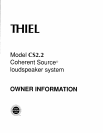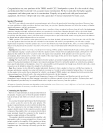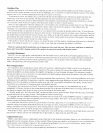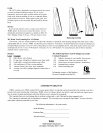
Congratulations
on
your
purchase
of the
THIEL model
CS2,2
loudspeaker system. It is
the
result
of a lon-e
and dedicated
eflort to
provide
verv
accurate
music reproduction. We have used
only the
highest
quality
components
and taken
great
care in its construction. Properly
set
up and used
with good
associated
equipment,
the
CS2.2s
will provide
vou
with
a
great
deal
of
musical enjoyment
for
many
years.
Speaker
Placement
The
CS2.2s
are relatively non-critical to room
piacerrent
and
will
provide good
results fiom
alrnost anywhere.
However.
here
are
some
guidelines
to help
vou
achieve the best
sound ll'clrn rour speirkers.
Speakerplaccrrent
will
atlect the accuracv o1'tirnbre.
spatial
perfbrmance.
and bass
pertbrmance.
Distance fiom rvalls:
THIEL
speakers. ancl
most
others.
souncl
best
rt they
are
placecl well
away
fronr
all
walls.
Such
placement
optimizes
imaging and depth. ancl musical tirlbres are
leproducecl u'itlr the least
coloration
because it
allows
the initial
sound
corning
from the speaker to be distinctly
separatecl in
time
frclrn
the
se,-'ondary sound of wall reflections. lf reflections
are
hearcl
too
clurckly
after the
prirrary sound.
1'our
brain tends to
interpret
thenr irs
part
of
the initial sound.
causins the
pefceived
timbre to
be altered and
the spatial chafacteristics to be confused.
THIEL speakers
will
sound best
when
placeri
at
least
one
tbot from:he back
wall
ancl at least
3
f'eet fiom the sicle wall. We like
to see the speakers
three f'eet fiom the rear
u'ail
ancl five f'eet tiom the
side wall. If
1'ou
experiment,
)'ou
u'ill notice
a major'
improvement in openness
when
the
speakers are even two t'eet tiom the rear
wall
instead of one. Also. it is not dcsirable fbr lar-se
objects to be
placed
near
the
spcakers since these
will
also be a source of unwanted early
reflections
that reclr.rce imaging
dccuracy.
Spacing:
Because of their
verv wicle.
even
ciispersion
of energy.
I'HIEL speakers should usually be
placetl
fnrthcr apart than
most. Optimum irlaging
is
usually achieved
when the speakers and th,: listener form an equilateral triangle. although this will
depend
on the
width
of the room-a
narrow room will recluire
closer
placeme
nt. If the spetrkers are too far apart fur
a
given
environment,
there
will
tend tcl be a
"hole"
in
the
rriclclle
of the sound
jta-ee:
if they are too close togethcr. thc irlage will
be
compressed
and will not achieve optimum
u'idth.
Aiming:
We
usually
pref'er
the
imagin-e
obtained
when
the
speakers are
pointed
straight ahead rather than
pointing
toward the
listener. This
placement produces
the
largest. most rratural
soundstage
However. toeing the speakers in somewhat rnay
produce
more specific
placements
of instruments. Also,
if it is
not
possible
to
.cet
the speakers
far enough
away
from
the sicle
walls,
a toed-
in
position
can
be helpful to reduce the strength of
wall reflections.
Bass:
Bass response is also afl-ectecl by speaker
placement.
In
generirl. when
a speaker
is close
to a
wall
the bass
response is
stl'onger ancl
placing
a speaker in a corner will make it even more so.
ln
order to achieve
properly
balanced bass.
it is necessary
for the speaker to be used
in the environment lor
which
it
was
designed. THIEL speakers are designed to
provide
accurate bass
when
positioned
away
fiom
all
walls-the same
position
that
provides
the best imaging.
Listener
position:
The CS2.2s
provide
broad dispersion of energy at all
frequencies ancl therefbre
provide good
results
throughout
a large listening area.
Best imaging is
provided
fbr
a
listener centered in fiont of the
speakers.
Optin'rum
phase
and
time alignment
is
provided
only
for
a seated
listener who is
eight or
more f-eet arvalr l-rorn the speakels.
and e.rperimentntiort
is necessctrt' to achieve
the bcst rcsults.
Connecting
the Speakers
The CS2.2's
input ten.r.rinals are located on the bottom of
the speaker. To
gain
iiccess to
these
the
speaker should be
laid on its back or side.
Muke
sure that all
(
ontrc(ti()ns dt
(
tight.
It is essential
fbr
proper perfbrmance
that both speakers
in
a stereo
system be
wired
in the same
polarity.
The
speaker's input terminals are
color
coded
to facilitate this.
The wire
connected
to the red input terminal of each
speaker should connect
to the respective
positive
output
terminals of the amplifier: the
wire
connected
to the black
input tenninals
should be connected to the
respective
negative output terminals of the amplifier.
The speakers should be connected to the
amplifier with
high
quality
cable
to ensure minimal loss of
power
and
proper
control by
the amplifier. lf the speakers are being
connected to a
vacuum
tube
amplifier
with various
impedance taps,
the
ul
ohm tap
will
usually
give
the best
results.
Bottom
View
of
Speaker






